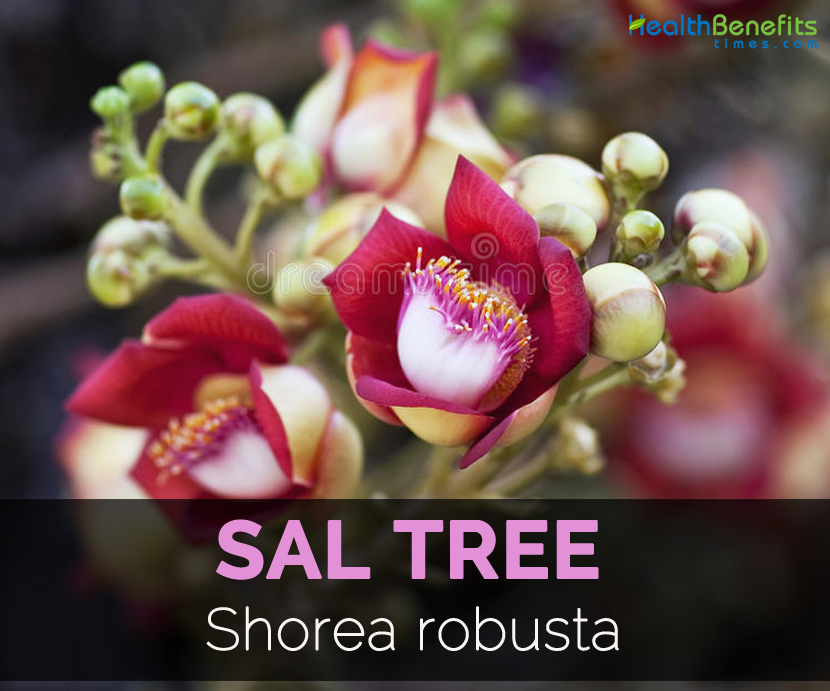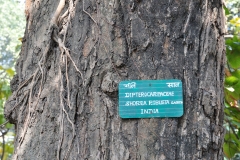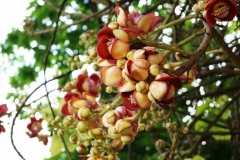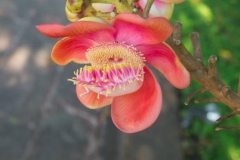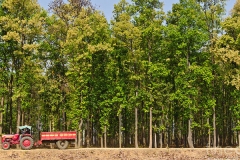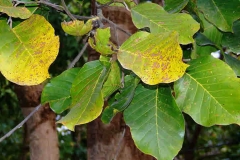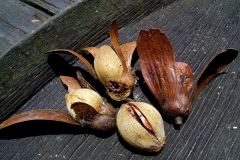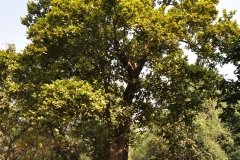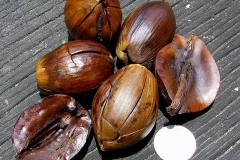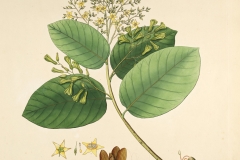Leaves are used for treating ulcers, wounds, leprosy, itching, earache, cough and headache. The bark when cut exudes oleoresin that has astringent and detergent properties. Resin is used to treat menorrhagia, eye irritations and spleen enlargement. Powdered bark, stem or bark paste is used to halt bleeding and promote healing of cuts.
Distribution
It is endemic to Indian subcontinent that ranges south of the Himalaya from Myanmar in the East to Nepal, Bangladesh and India. It extends from Assam, Odisha, Bengal and Jharkhand westto Shivalik Hills in Haryana in India. It also extends through Eastern Ghats and to eastern Vindhya and Satpura ranges of Central India. In Nepal, it is found in Terai region from east to west in Sivalik Hilla in subtropical climate. In Northern India, it is found in Odisha, Madhya Pradesh and Jharkhand.
Health Benefits of Sal Tree
- Wound healing
Sal tree sap is used for treating agonizing swelling. It has rala which acts as effective astringent and anti-microbial properties. Rala cleanses wounds and facilitate healing of wounds.
- Acts as astringent
Tree has astringent properties which are found to be helpful for treating dysentery and diarrhea. Tree extracts are considered to be strong astringent agents. It is beneficial for those suffering from diarrhea.
- Skin health
Sal tree possess astringent properties which is an ingredient in herbal ointments for skin problems and ear ailments. Various shorea ointments are available in the market for skin ailments. Moreover, it nourishes the skin being rich in essential vitamins and minerals. It is a smart choice to get radiant skin naturally without artificial methods.
- Therapeutic properties
Sal tree has effective therapeutic properties which is beneficial for maintaining overall health. It has therapeutic properties from oleoresin that contains triterpenoids, the derivatives of ursonic, triterpene and olenane acid.
- Healthy hair
Sal tree extracts have astringent properties which is beneficial for maintaining skin care and hair care. It cleanses the hair as well as skin.
- Treatment for piles
It is commonly used in Ayurveda, Unani and tribal systems of medicine. It is effective to halt bleeding piles and also provide relief to the patients experiencing piles.
- Helpful for arthritis
The resin obtained from sal tree bark is helpful in providing relief from arthritis. Mix few grams of resin with egg whites and apply this paste to the affected portion. It provides relief from joint pain caused due to arthritis.
- Antibacterial properties
It possesses antibacterial properties that eliminate germs and bacteria. The herbal cream prepared from leaves of Shorea is helpful to speed up the healing process.
- Treat infections
Shorea robusta has antioxidants that exterminate infections in the body. It has antioxidants that neutralize infections. It promotes infection combating capabilities of the body resulting sooner recovery from infections.
- Strengthen immunity
Shorea robusta helps to promote immunity of the body. This herb is beneficial for those who wish to promote immunity level of the body. It is incredible to maintain overall health.
- Supports digestion
The properties available in the herb help in proper digestion. It assists the body to cure digestion associated problems easily. It has so many healthy features that help to improve health.
- Ear infections
The herb has essential nutrients and medicinal properties which is crucial for ear health. Try shorea robusta if experiencing ear infection.
Medicinal uses
- Bark and leaves are helpful for ulcers, wounds, cough, leprosy, earache, gonorrhea and headache.
- Use the bark for dysentery, diarrhea and vaginal discharges.
- Fruits are used for seminal weakness, tubercular ulcers, dermopathy and burning sensation.
- Use it in vitiated conditions of pitta, ulcers, wounds, burns, neuralgia, fever, dysentery, diarrhea, obesity, splenomegaly, obesity and eyes burning.
- It is used with sugar or honey for treating dysentery and bleeding piles in Ayurveda.
- Use it for gonorrhea and weak digestion.
- Apply the bark decoction as drops for ear problems and fruits for diarrhea
- Mix it with boiled milk and use it as a cure for cough, bronchitis, piles and leucorrhoea.
- Resin is used for treating gonorrhea, dysentery, toothache and boils.
- Use the leaf juice for treating dysentery.
- Use the leaves as a poultice on the swollen areas of the body.
- Apply it to children’s stomach to treat dysentery.
- Seed oil is used for treating skin problems.
- Take the gum resin internally for bloody diarrhea, uteral discharges and bleeding piles
- Gum resin is also applied on skin eruptions, infected wounds and ulcers.
- Take the bark tea orally for five days to treat typhoid.
- It is also used as a foot care cream.
- Fruits are used for treating epilepsy, excessive salivation and chlorosis.
- Use the seeds powder for treating dental problems.
Culinary uses
- Seeds are boiled, roasted or grounded into flour.
- Make porridge by boiling seeds with fruits of Dolichos biflorus and flowers of Bassia latifolia.
- The grounded flour is used for making bread.
- Seeds are used to extract oil.
- The seed oil is used as a substitute for cocoa butter in making chocolates.
Medicinal uses
Analgesic (resin): Relieve pain.
Anti–inflammatory (leaves decoction): Lowers inflammation
Antipyretic (resin): Effective for fever.
Anti-nociceptive (leaves): Inhibits nociception, the sensation of pain
Antiulcer (resin): Tending to prevent or heal ulcers
Anti–Obesity (leaves): Reduces obesity
Immunomodulatory (bark): Modifies the immune response or the functioning of the immune system.
Wound healing: Heals the wound.
Dosage
Powder: 3-5 grams
Decoction: 50-100 ml
Gum-resin: 1-3 grams
Side effects
- Pregnant and breastfeeding mothers should consult the doctor for use.
- Avoid its use if experienced any allergic reactions.
References:
https://pfaf.org/user/Plant.aspx?LatinName=Shorea+robusta
https://www.itis.gov/servlet/SingleRpt/SingleRpt?search_topic=TSN&search_value=506787#null
https://en.wikipedia.org/wiki/Shorea_robusta
http://www.tropical.theferns.info/viewtropical.php?id=Shorea+robusta
https://www.bimbima.com/ayurveda/sal-tree-shorea-robusta-information-and-uses/49/
https://easyayurveda.com/2012/10/03/sal-tree-shorea-robusta-ayurveda-details-and-health-benefits/
Comments
| Sal Tree Quick Facts | |
|---|---|
| Name: | Sal Tree |
| Scientific Name: | Shorea robusta |
| Origin | Indian subcontinent, ranging south of the Himalaya, from Myanmar in the east to Nepal, India and Bangladesh. |
| Colors | Pale yellowish or green |
| Shapes | Oval, 1.3-1.5 cm long and 1 cm in diameter |
| Name | Sal Tree |
|---|---|
| Scientific Name | Shorea robusta |
| Native | Indian subcontinent, ranging south of the Himalaya, from Myanmar in the east to Nepal, India and Bangladesh. |
| Common/English Name | Sakhua, Sal, Shala tree |
| Name in Other Languages | Arabic: Qanquahar; Assamese: Sal; Bengali: sakher, sal ( साल), sakhu, salwa; Burmese: Enkhyen; Chinese: Suo Luo Shuang, Suo Luo Shuang Shu; English: common sal, sal seeds, indian dammer, sal tree, yellow balau; French: Arbre, Balau Jaune, Sal, Dammar De Linde, Sal; German: salharzbaum, salbaum; Gujarati: Ral; Hindi: Dhuna, Jall, Damar, Salwa, Sal, Shal; India: Jall, salwa, sal, shal; Japanese: Serangan Batsuu, Sara Noki, Shara Noki, serangan batsuu; Malay: damar laut, selangan batu, bangkirai, selangan batu kumus; Marathi: Guggilu, Rala; Nepalese: sakhuvaa, sal, agrakh, sakwa, sakhua, sal; Oriya: Sagua, Salwa, Sal, Sekwa; Punjabi: Sal, Seral; Russian: Sal, Shoreia Moshchnaia, Salovoe Derevo; Sanskrit: Agnivallabha, Ashvakarnika, Ashvakarna, Dhanya, Chiraparna, Dirghaparna, Divyasara, Dirghashaka, Jaranadruma, Jaladashara, Kaushikahva, Lalana, Kushika, Latashankha, Rala, Latataru, Ralakarya, Salaniryas, Sala, Salaveshta, Sarjakarya, Sarja, Sarjarasa, Sarjjaka, Sasyasamvera, Sasyasambara, Shankurriksha, Shankataru, Shasyasambara, Shura. Sidhaka, Tarkshyapravasa, Sureshtaka, Vallivriksha, Vastakarna, Vansha, Yakshadhupa; Sinhalese: Dammala; Swedish: Sal-träd; Urdu: ral, raal; Tamil: Kungiliyam, Saruva rasam, Kungiligam, Gugglu, Kukkil; Telugu: Guggilamu, Saluva, Gugal, Sarjmu; Urdu: Ral; Unani: Raal (resin); Siddha: Kungilyam |
| Plant Growth Habit | Evergreen tree |
| Soil | Deep, well-drained, moist, slightly acid, sandy to clayey |
| Plant Size | 50 m tall |
| Bole | Straight and cylindrical |
| Bark | Dark brown |
| Leaf | Simple, shiny, glabrous, about 10-25 cm long |
| Flowering Season | March–April |
| Flower | Yellowish-white, small |
| Fruit shape & size | Oval, 1.3-1.5 cm long and 1 cm in diameter |
| Fruit color | Pale yellowish or green |
| Seed | Oval, light brown |


